Evaluation of Materials and Structures with a Multistatic Ultra-Wideband Impulse Radar: A Concept Validation
Abstract
1. Introduction
2. Materials and Methods
- Upgrade the existing EDI pseudo-monostatic UWB IR radar [25] to a multistatic system in order to validate theory with results of experiments;
- Develop a model that describes the passing of the multistatic UWB IR signals through a layered medium of various configurations, and that could be used to generate correct synthetic NN training data sets;
- Develop signal preprocessing methods based on multidimensional representations (time frequency, time scale, etc.) and signal decomposition, combining signals reflected from and propagated through a medium in order to ensure improved accuracy and/or reduced complexity of the NN-based analysis;
- Research favorable NN architecture (recurrent NN, long short-term memory NN, pulse-coupled NN, transformers, convolution NN (CNN), etc.) and its enhancement for optimal (precision, complexity, etc.) estimation of object material and its structure.
2.1. Ultra-Wideband Impulse Radar
2.2. Synthetic Data Generation
- A
- Choice of the NN architecture;
- B
- Selection of raw signal preprocessing methods;
- C
- Methodology of the model development and its hyperparameter tuning;
- D
- Selection of loss function;
- E
- Impact of noise.
- Cleaned time domain data;
- Principal component analysis (PCA);
- Amplitude spectrum;
- Phase spectrum;
- Short-time Fourier transform (STFT) [34].
- Introduction of single-parameter-varying () data sets to the CNN to define favorable loss function.
- Introduction of two-parameter-varying data sets to evaluate impact on the parameter prediction error with different antenna setups and data representations, and to determine favorable antenna setup signal and data representation.
- Addition of the Gaussian noise of different SNRs to the clearly monostatic case to test the NN model and study the impact of noise on prediction accuracy, and to determine the threshold of the noise level when parameter estimation becomes corrupted.
- Use the chosen data representation signal setup for the addition of different levels of noise up to the threshold of the generator signal in the simulation to estimate the impact on the addition of noisy data to the data sets for NN model sustainability.
2.3. Neural Networks
- Noise level of 10% to whole signal;
- Noise level of 20% to whole signal;
- Noise level of 20% to parts of signal (noise spikes).
3. Results and Discussion
3.1. Development of the Multistatic UWB IR
- Designing the antenna switch that ensures good isolation between channels (for signals up to 3 GHz in frequency, dB when the channel is on, and dB when the channel is off);
- Redesigning the firmware of the existing radar in order to support multistatic radar data flow;
- Designing the human–machine interface software of the upgraded radar.
- Pseudo-monostatic radar, in the case when the receiving antenna is placed next to the transmitting antenna;
- Bistatic radar, in the case when the receiving antenna is not placed next to the transmitting antenna;
- Multistatic radar, in the case when multiple receiving antennas are used.
3.2. The Developed Model for Determination of Dielectric Parameters of Objects Using UWB Impulse Radar
- —The unknown magnitude of the wave that comes from the transmitting antenna ;
- , —Waves reflected from the boundaries between front and back of the object measured by the receiving antenna ;
- —The wave that has passed through object;
- —The loss tangent of object;
- —The distance from the antennas to the object.
3.3. Model Conformation Using Synthetic Data
3.4. The Synthetic Data Generation
- The comparison of the simulation output with the experimental measurement results;
- The validation of the developed EM wave propagation model;
- The generation of data for the training of the NN and development of NN architectures.
- The dielectric block wall scene was simulated imitating monostatic and bistatic radar configurations in order to
- −
- Validate the developed EM wave propagation model;
- −
- Compare synthetic data with experimental measurements;
- −
- Generate data sets for NN training and evaluation.
Simulation of this scene took a lot of time since the dimensions of the scene were around 70 wavelengths, and real radar antennas in the simulation were used, which lead to a very large mesh size. The front of the wall was up to 4.4 × 4.4 m (in order to shift the reflection from the wall vertexes outside the time window when the signal is reflected from the bricks of the back wall); the physical parameters of the scene were variable:- −
- Distance to the wall, 350 to 700 mm;
- −
- Thickness of the wall, 200 to 500 mm;
- −
- Relative dielectric permittivity of the wall, 1 to 6;
- −
- Dielectric losses of the wall, 0 to 0.1.
- The dielectric ball (13 cm in diameter) was simulated imitating real bistatic and multistatic radar scene configurations in order to rapidly generate NN training data. This scene was simulated instancing eight simple half-wave dipole antennas in close proximity to the ball in order to minimize the size of the scene’s mesh and obtain training data as quick as possible. Antennas were equidistantly placed on the square, which was 200 × 200 mm in size. The physical parameters of the scene were variable:
- −
- Relative dielectric permittivity of the ball, 1 to 6;
- −
- Dielectric loss of the ball, 0 to 0.25.
- The Gaussian signal (Figure 5a), since it is continuous and its spectrum due to the Fourier transform properties is also Gaussian, and therefore also continuous. The spectrum of the used Gaussian signal is similar to the spectrum of the radar signal used at the beginning of the project, so this signal was used during simulations of the first data sets for NN training, since the model of the developed EDI radar was not yet developed;
- The sine signal truncated to a single period (Figure 5b), since it provided better results in terms of finding the proper positions in time when analyzing the reflected signals in the developed model of EM wave propagation;
- The signal of the EDI radar (Figure 5c), since it should provide simulation results that were the most similar to the experimental results. The signal of the EDI radar was modeled using the 66 most powerful components of the discrete cosine transform from the recorded EDI radar signal. This signal was used for the generation of synthetic data for NN training and evaluation. This signal was also used for noisy transmitted signal generation, varying, by up to 20%, the DCT coefficient values in order to simulate the imperfectly matching radar signals.
3.5. The Synthetic and Experimental Data Comparison
- In order to make calculations faster, the simulation was generated using simplified antenna model possessing
- A frequency-independent antenna and substrate dielectric losses equal to 0.026;
- An infinitely thin perfect electric conductor of antenna surfaces;
- The radar signal was measured on a 50 load instead of actual antenna impedance (Figure 8), due the lack of the active high-impedance RF probe for frequencies 2 to 10 GHz.
3.6. Parameter Estimation Using the NN
- For frequency domain representations, the phase spectra data sets for both estimated parameters showed better results as the data were more informative than in the amplitude spectra data sets. The prediction error is and times smaller with phase spectrum than the amplitude spectrum for and , respectively (multistatic setup). The spectrum component number impact was also studied, where the latter components served as noise and decreased the performance of the NN training;
- The STFT preprocessing showed improved results compared to the previous data representations due to the ability of the method to extract the most valuable information from time and frequency domain data. With STFT, parameter prediction error is units smaller for and times smaller for compared to the phase spectrum results for multistatic setup. As the data sets of STFT are presented as 2D images with additional features of RGB color intensity, the number of input data dimensions increased. Therefore, the number of trainable parameters increased by to times depending on the antenna setup, which led to a training time increase;
- Finally, the PCA preprocessing showed best prediction error results for both estimated parameters, with for and for . The performed tests indicate that simplification of the data by feature vector reduction was achieved. Therefore, the training time is reduced (by to times compared to the STFT on multistatic setup data) along with trainable weight parameters (by to times). The PCA method also allowed us to train the neural network model with the same number of training parameters for every setup, as the number of principal components remained the same. The method itself was implemented via the scikit-learn machine learning library to perform such dimensional reduction. The PCA class was used to fit and transform the raw input data.
- Whether the parameter evaluation is achievable with noisy data;
- Whether parameter prediction is possible on noisy data while training with synthesized data without any noise added;
- How the noise level affects the accuracy of the parameter prediction.
3.7. Monostatic and Multistatic Radar Application for Material and Structure Recognition
- The object detection accuracy was worst in the case of the monostatic radar [29];
- In the case of the multistatic radar, the detection accuracy increased by 6% in comparison to monostatic or bistatic radar cases;
- Switching from monostatic to multistatic radar increases the detection accuracy for a variety of tested NNs and for simple NN architectures, and reduces the mistakenly classified object count up to four times [30].
3.8. Comparison of Different Neural Network Architectures in UWB IR Signal Processing
- The difference in proper waste detection accuracy for simple NN architectures (multilayer perceptron and convolution NN) and dense NN architectures (Transformer and ResNet) in the case of the monostatic radar is up to 1.9% in favor of dense NN architectures; at the same time, this means a difference in counts of mistakenly recognized objects of up to four times;
- In the case of simple NN architectures switching from monostatic to multistatic radar increases the detection accuracy up to 1.8%;
- In the case of most dense NN architectures, switching from monostatic to multistatic radar increases the detection accuracy only by a fraction of a percent.
4. Future Research
- The conformance of the developed mathematical model of EM propagation through a layered medium to the simulation can be improved (please see Conclusion in [39]);
- Many NN architectures were not tested [29];
- Wavelets for data preprocessing were not tested;
- The classification of real waste could be improved using radar data and visual camera data fusion in NN;
- The experimental setup can be developed into industrial waste sorting equipment: the antennas could be placed around the conveyor belt pointing towards a single piece of waste on a belt at a 30 to 45 degree angle; in order to avoid EM interference with other equipment in waste sorting centers, the area surrounding the antennas will probably need to be shielded; the radar itself can be made airtight and powered using Power over Ethernet.
5. Conclusions
Author Contributions
Funding
Institutional Review Board Statement
Informed Consent Statement
Data Availability Statement
Conflicts of Interest
Abbreviations
| EDI | Elektronikas un datorzinātņu institūts (Institute of Electronics and Computer Science) |
| UWB | Ultra-wideband |
| IR | Impulse radar |
| EM | Electromagnetic |
| NN | Artificial neuron network |
| CNN | Convolution neural network |
| FDTD | Finite difference time domain |
| PCA | Principal component analysis |
| STFT | Short-time Fourier transform |
| MSE | Mean squared error |
References
- Turvey, S.T.; Crees, J.J. Extinction in the Anthropocene. Curr. Biol. 2019, 29, R982–R986. [Google Scholar] [CrossRef] [PubMed]
- Barrett, J.; Chase, Z.; Zhang, J.; Holl, M.M.B.; Willis, K.; Williams, A.; Hardesty, B.D.; Wilcox, C. Microplastic pollution in deep-sea sediments from the Great Australian Bight. Front. Mar. Sci. 2020, 7, 808. [Google Scholar] [CrossRef]
- Palmer, J.; Herat, S. Ecotoxicity of Microplastic Pollutants to Marine Organisms: A Systematic Review. Water Air Soil Pollut. 2021, 232, 1–21. [Google Scholar] [CrossRef]
- Pivokonsky, M.; Cermakova, L.; Novotna, K.; Peer, P.; Cajthaml, T.; Janda, V. Occurrence of microplastics in raw and treated drinking water. Sci. Total. Environ. 2018, 643, 1644–1651. [Google Scholar] [CrossRef]
- Sharma, R.; Kaushik, H. Micro-plastics: An invisible danger to human health. Cgc Int. J. Contemp. Technol. Res. 2021, 3, 1–5. [Google Scholar] [CrossRef]
- Bhattacharya, P. A review on the impacts of microplastic beads used in cosmetics. Acta Biomed. Sci 2016, 3, 47–52. [Google Scholar]
- Zhihong, C.; Hebin, Z.; Yanbo, W.; Binyan, L.; Yu, L. A vision-based robotic grasping system using deep learning for garbage sorting. In Proceedings of the 2017 36th Chinese Control Conference (CCC), Dalian, China, 26–28 July 2017; pp. 11223–11226. [Google Scholar]
- Mäkelä, M.; Rissanen, M.; Sixta, H. Machine vision estimates the polyester content in recyclable waste textiles. Resour. Conserv. Recycl. 2020, 161, 105007. [Google Scholar] [CrossRef]
- Zhang, C.; Sargent, I.; Pan, X.; Li, H.; Gardiner, A.; Hare, J.; Atkinson, P.M. An object-based convolutional neural network (OCNN) for urban land use classification. Remote. Sens. Environ. 2018, 216, 57–70. [Google Scholar] [CrossRef]
- Dębska, B.; Guzowska-Świder, B. Application of artificial neural network in food classification. Anal. Chim. Acta 2011, 705, 283–291. [Google Scholar] [CrossRef] [PubMed]
- Lam, H.K.; Ekong, U.; Liu, H.; Xiao, B.; Araujo, H.; Ling, S.H.; Chan, K.Y. A study of neural-network-based classifiers for material classification. Neurocomputing 2014, 144, 367–377. [Google Scholar] [CrossRef]
- Tibshirani, R. A comparison of some error estimates for neural network models. Neural Comput. 1996, 8, 152–163. [Google Scholar] [CrossRef]
- Marquez, L.; Hill, T.; Worthley, R.; Remus, W. Neural network models as an alternative to regression. In Proceedings of the Proceedings of the Twenty-Fourth Annual Hawaii International Conference on System Sciences, Kauai, HI, USA, 8–11 January 1991; Volume 4, pp. 129–135. [Google Scholar]
- Dhillon, A.; Verma, G.K. Convolutional neural network: A review of models, methodologies and applications to object detection. Prog. Artif. Intell. 2020, 9, 85–112. [Google Scholar] [CrossRef]
- Li, X.; He, Y.; Jing, X. A survey of deep learning-based human activity recognition in radar. Remote Sens. 2019, 11, 1068. [Google Scholar] [CrossRef]
- Zhang, Z.; Tian, Z.; Zhou, M. Latern: Dynamic continuous hand gesture recognition using FMCW radar sensor. IEEE Sens. J. 2018, 18, 3278–3289. [Google Scholar] [CrossRef]
- Yin, W.; Yang, X.; Zhang, L.; Oki, E. ECG monitoring system integrated with IR-UWB radar based on CNN. IEEE Access 2016, 4, 6344–6351. [Google Scholar] [CrossRef]
- Sadreazami, H.; Bolic, M.; Rajan, S. On the use of ultra wideband radar and stacked LSTM-RNN for at home fall detection. In Proceedings of the 2018 IEEE Life Sciences Conference (LSC), Montreal, QC, Canada, 28–30 October 2018; pp. 255–258. [Google Scholar]
- Lombacher, J.; Hahn, M.; Dickmann, J.; Wöhler, C. Potential of radar for static object classification using deep learning methods. In Proceedings of the 2016 IEEE MTT-S International Conference on Microwaves for Intelligent Mobility (ICMIM), San Diego, CA, USA, 19–20 May 2016; pp. 1–4. [Google Scholar]
- Brodeski, D.; Bilik, I.; Giryes, R. Deep radar detector. In Proceedings of the 2019 IEEE Radar Conference (RadarConf), Boston, MA, USA, 22–26 April 2019; pp. 1–6. [Google Scholar]
- Gulck, A.; Lehmann, T.; Knochel, R. Characterisation of dielectric obstacles using ultra-wideband techniques. In Proceedings of the European Radar Conference, 2005, EURAD 2005, Paris, France, 3–4 October 2005; pp. 259–262. [Google Scholar]
- Yeo, H.S.; Flamich, G.; Schrempf, P.; Harris-Birtill, D.; Quigley, A. Radarcat: Radar categorization for input & interaction. In Proceedings of the Proceedings of the 29th Annual Symposium on User Interface Software and Technology, Tokyo, Japan, 16–19 October 2016; pp. 833–841. [Google Scholar]
- Sardar, S.; Mishra, A.K. Uwb based dielectric material characterization using hardware/software co-design based ann. In Proceedings of the 2013 IEEE International Conference on Industrial Technology (ICIT), Cape Town, South Africa, 25–28 February 2013; pp. 1196–1200. [Google Scholar]
- Sardar, S.; Mishra, A.K. UWB based dielectric material characterization using PCNN based ASIN framework. In Proceedings of the 2014 International Conference on Advances in Electrical Engineering (ICAEE), Vellore, India, 9–11 January 2014; pp. 1–5. [Google Scholar]
- Aristov, V.; Gaigals, G.; Supols, G.; Lobanovs, E.; Riekstins, V.; Zujs, V. Ultra-Wideband Pulse Radar with Discrete Stroboscopic Receiver for Detection of Small Targets Behind Dielectric Obstacles. Transp. Telecommun. 2021, 22, 196–206. [Google Scholar] [CrossRef]
- Liebig, T. openEMS-Open Electromagnetic Field Solver. Available online: https://www.openEMS.de (accessed on 3 January 2022).
- Géron, A. Hands-On Machine Learning with Scikit-Learn, Keras, and TensorFlow: Concepts, Tools, and Techniques to Build Intelligent Systems; O’Reilly Media: Sebastopol, CA, USA, 2019. [Google Scholar]
- Zhang, A.; Lipton, Z.C.; Li, M.; Smola, A.J. Dive into deep learning. arXiv 2021, arXiv:2106.11342. [Google Scholar]
- Greitans, K.; Greitans, M. Multi-static UWB radar for classification of objects from different materials. In Proceedings of the 2021 IEEE Microwave Theory and Techniques in Wireless Communications (MTTW), Riga, Latvia, 7–8 October 2021; pp. 7–11. [Google Scholar]
- Greitans, K.; Greitans, M. Applicability of different neural network architectures in UWB signal processing for different object classification. In Proceedings of the 2022 Workshop on Microwave Theory and Techniques in Wireless Communications (MTTW), Riga, Latvia, 5–7 October 2022; pp. 138–143. [Google Scholar]
- Gulli, A.; Pal, S. Deep Learning with Keras; Packt Publishing Ltd.: Birmingham, UK, 2017. [Google Scholar]
- Gulli, A.; Kapoor, A.; Pal, S. Deep Learning with TensorFlow 2 and Keras: Regression, ConvNets, GANs, RNNs, NLP, and More with TensorFlow 2 and the Keras API; Packt Publishing Ltd.: Birmingham, UK, 2019. [Google Scholar]
- Maliks, R.; Kadikis, R. Multispectral data classification with deep CNN for plastic bottle sorting. In Proceedings of the 2021 6th International Conference on Mechanical Engineering and Robotics Research (ICMERR), Krakow, Poland, 11–13 December 2021; pp. 58–65. [Google Scholar]
- Akansu, A.N.; Haddad, R.A.; Haddad, P.A.; Haddad, P.R. Multiresolution Signal Decomposition: Transforms, Subbands, and Wavelets; Academic Press: Cambridge, MA, USA, 2001. [Google Scholar]
- Nugroho, A.; Suhartanto, H. Hyper-Parameter Tuning based on Random Search for DenseNet Optimization. In Proceedings of the 2020 7th International Conference on Information Technology, Computer, and Electrical Engineering (ICITACEE), Semarang, Indonesia, 24–25 September 2020; pp. 96–99. [Google Scholar]
- Yoo, J.H.; Yoon, H.i.; Kim, H.G.; Yoon, H.S.; Han, S.S. Optimization of Hyper-parameter for CNN Model using Genetic Algorithm. In Proceedings of the 2019 1st International Conference on Electrical, Control and Instrumentation Engineering (ICECIE), Kuala Lumpur, Malaysia, 25 November 2019; pp. 1–6. [Google Scholar]
- Hinz, T.; Navarro-Guerrero, N.; Magg, S.; Wermter, S. Speeding up the hyperparameter optimization of deep convolutional neural networks. Int. J. Comput. Intell. Appl. 2018, 17, 1850008. [Google Scholar] [CrossRef]
- Loy, J. Neural Network Projects with Python: The Ultimate Guide to Usingn Python to Explore the True Power of Neural Networks through Six Projects; Packt Publishing Ltd.: Birmingham, UK, 2019. [Google Scholar]
- Gaigals, G.; Aristov, V.; Greitans, M. Conformance analysis of model for material properties determination using simulation of ultra-wideband pulse radar. In Proceedings of the 2021 IEEE Microwave Theory and Techniques in Wireless Communications (MTTW), Riga, Latvia, 7–8 October 2021; pp. 35–39. [Google Scholar]
- Aristov, V.; Greitans, M. Determination of the Electrophysical Parameters of Dielectric Objects via the Processing of Ultra-Wideband Pulse Radar Signals. Autom. Control. Comput. Sci. 2021, 55, 577–587. [Google Scholar] [CrossRef]
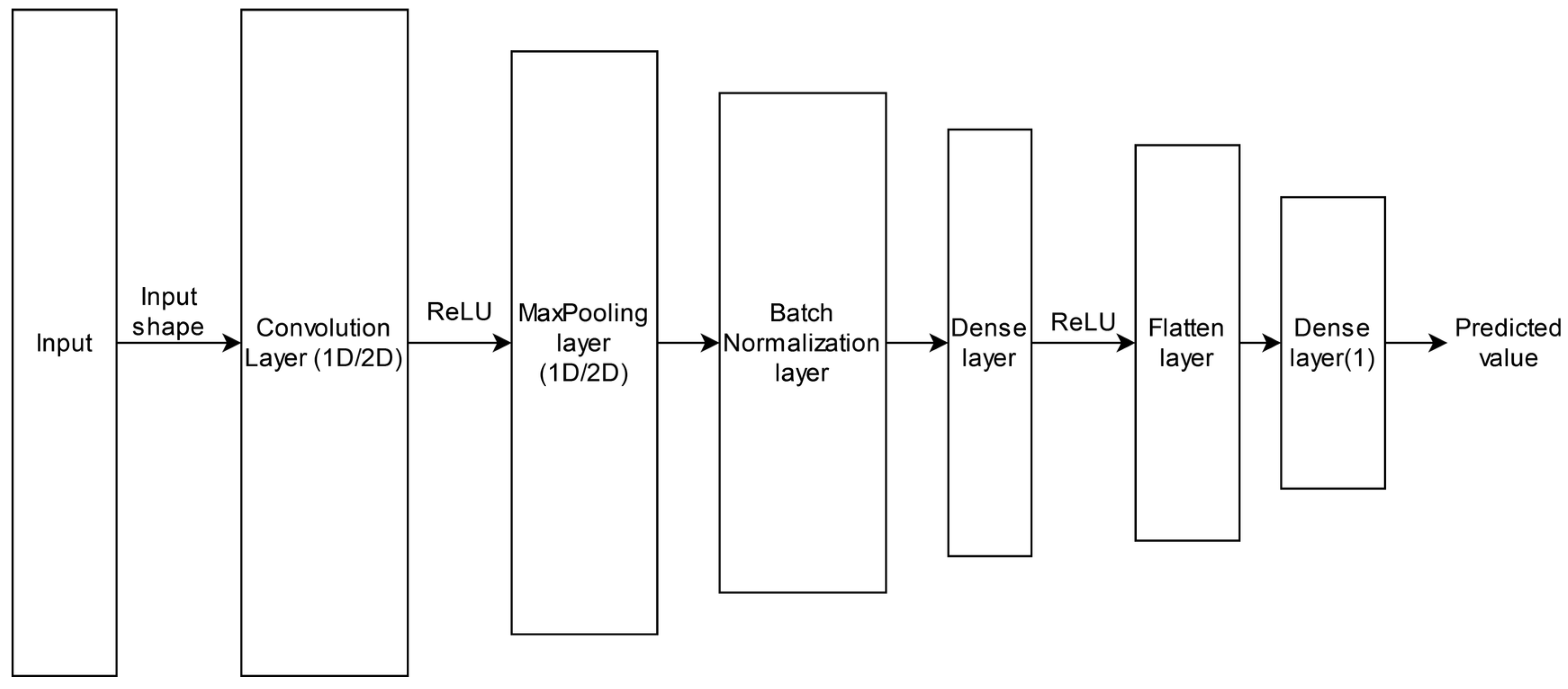
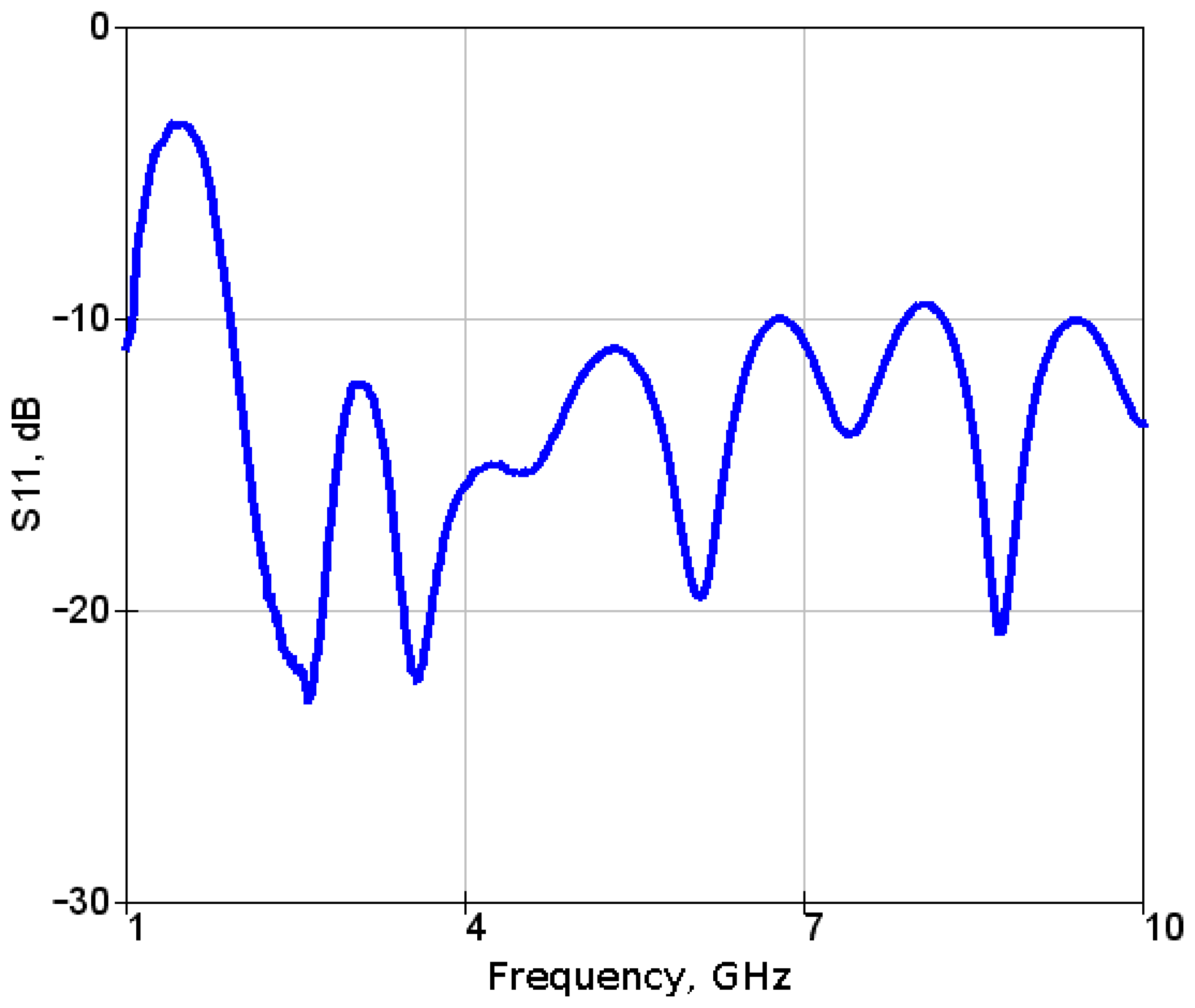

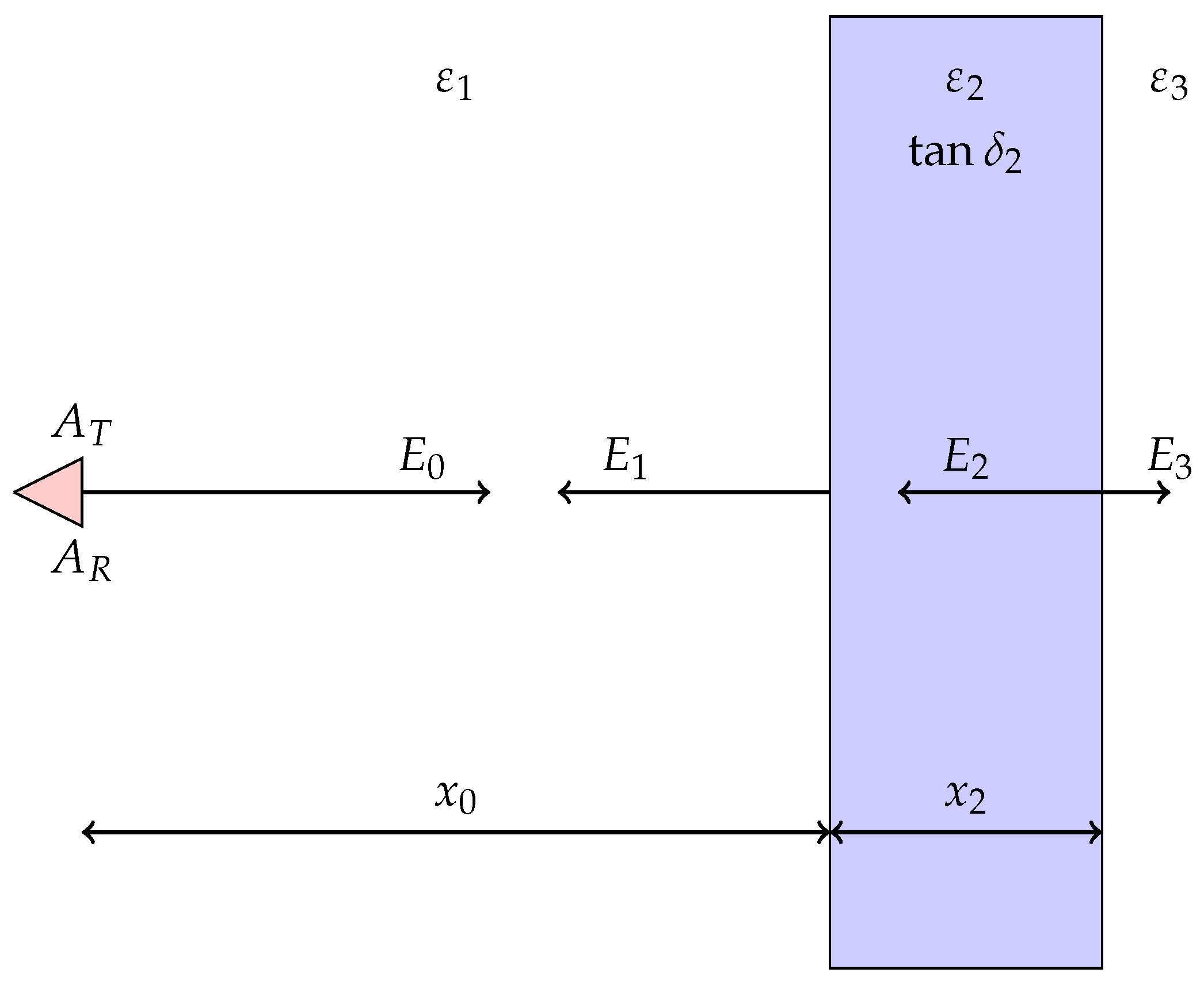
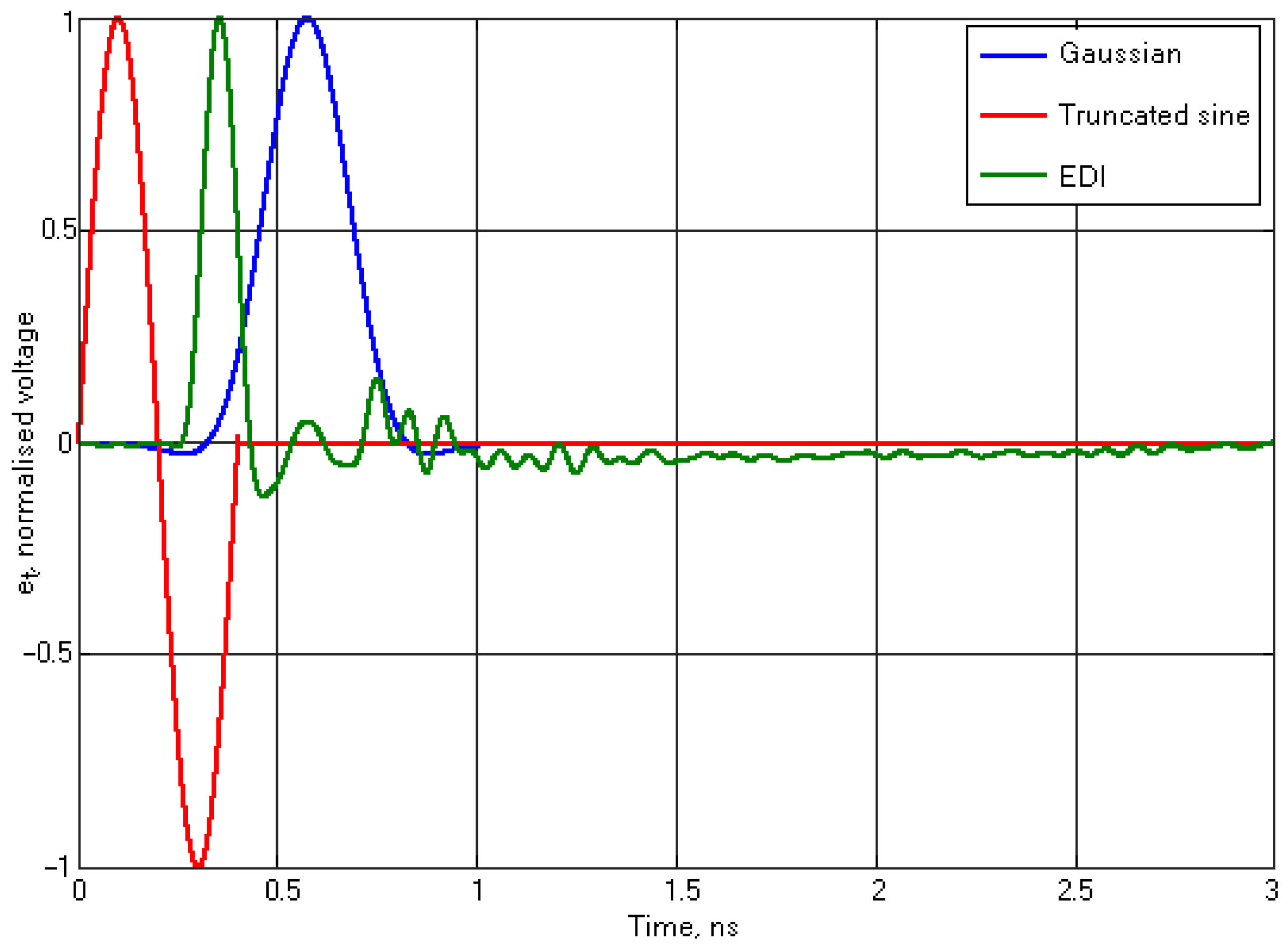
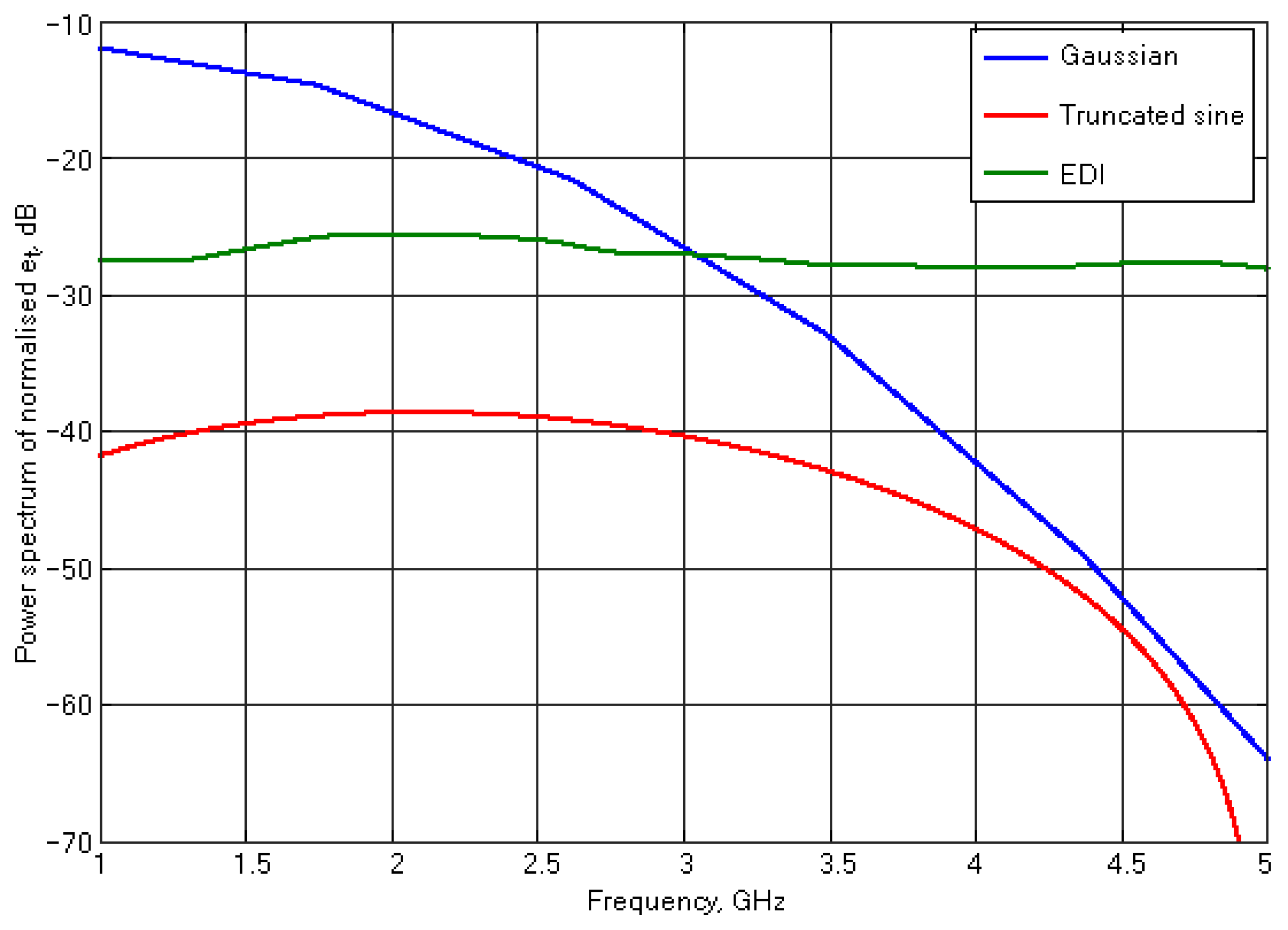
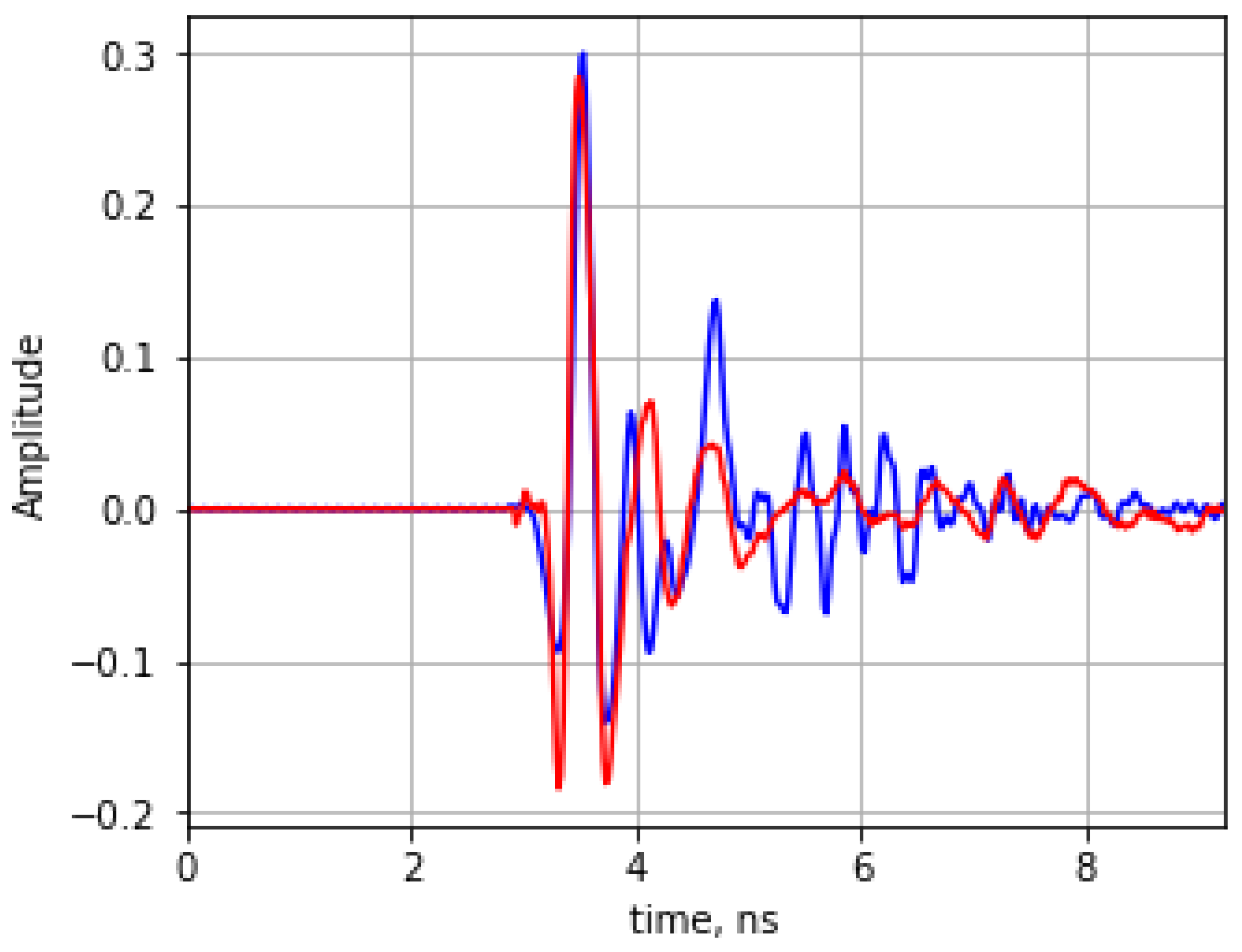
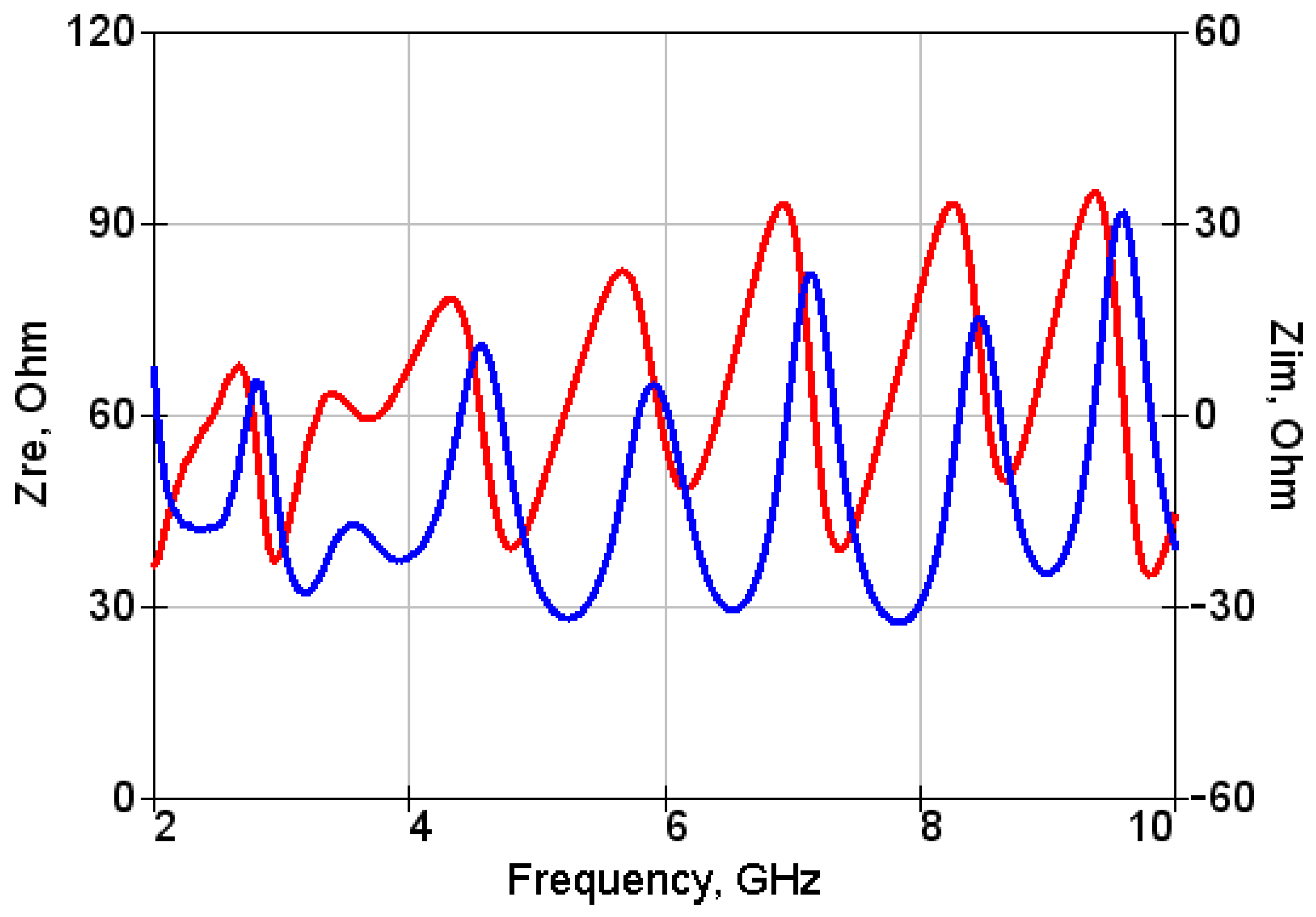
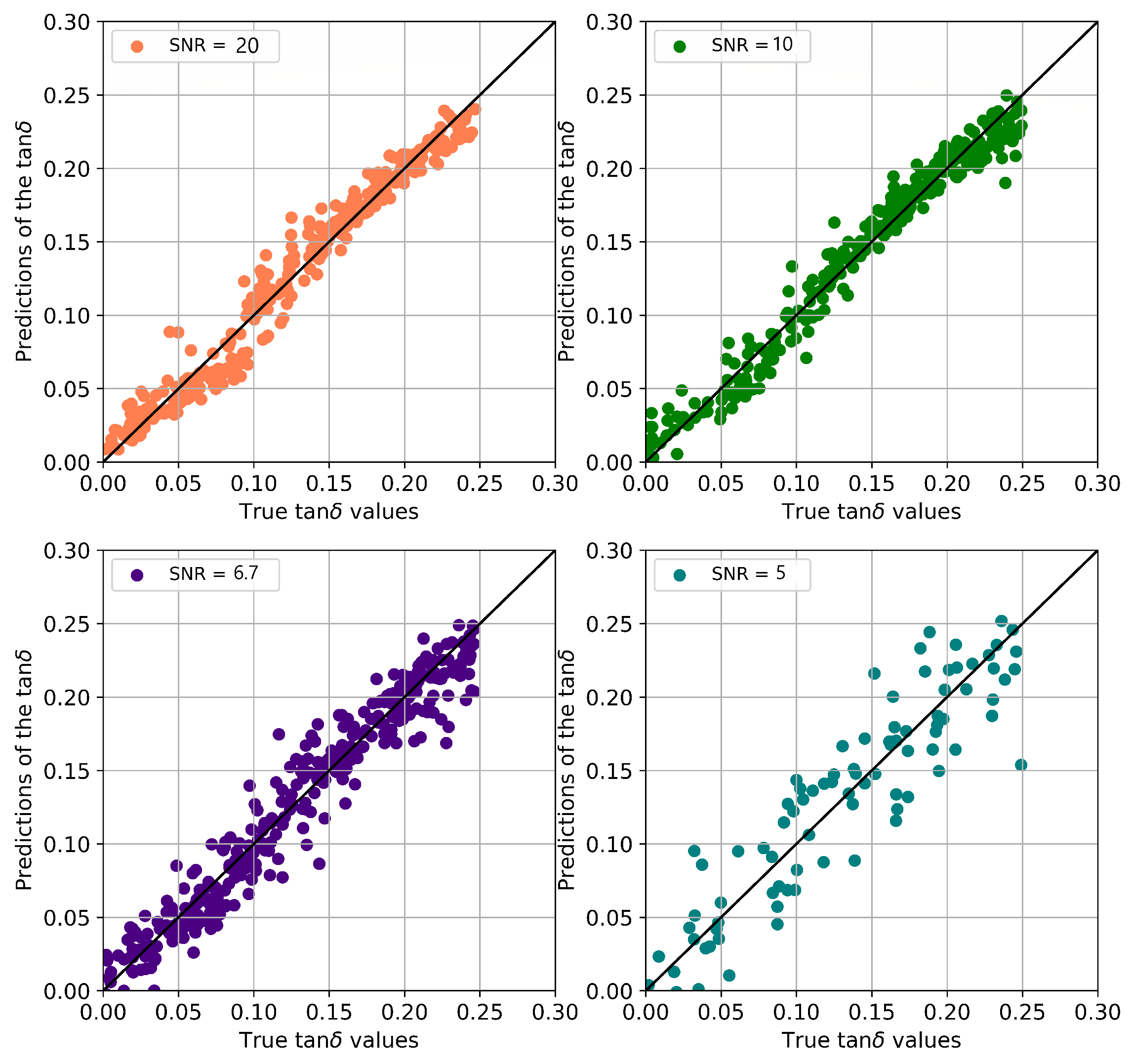
| Property | Value |
|---|---|
| Size, mm | 60.5 × 98.5 |
| Input voltage PoE or AUX, V | 12 to 48 |
| Antenna connector type | SMA |
| Pulse repetition frequency, MHz | 1.38 |
| Time window, ns | 18 to 50 |
| Sample count | 400 to 4096 |
| Equivalent sample rate, GSps | 8 to 130 |
| ADC sample size, bits | 8 to 12 |
| Communication interface | Ethernet |
| Pulse bandwidth, GHz | 2 to 4.5 |
| Pulse voltage on 50 Ohm load, V | 6 |
| Pulse rise time, ps | 55 |
| Pulse half width time, ps | 98 |
| Output impedance, Ohm | 50 |
| Dynamic range of the receiver, dB | 60 |
| Input noise level of the receiver, mV | 1 |
| Repres. | Signal | Error in Prediction × 10 | Training Time (s) | Parameters |
|---|---|---|---|---|
| Time domain | Refl. | 170.37 ± 4.81 | 9.12 | 13625 |
| Trans. | 195.12 ± 3.99 | 8.96 | 13625 | |
| Bist. | 123.39 ± 2.67 | 19.79 | 25913 | |
| Multist. | 60.61 ± 1.96 | 24.83 | 38201 | |
| PCA | Refl. | 2.82 ± 0.08 | 2.8 | 1619 |
| Trans. | 3.25 ± 0.09 | 2.98 | 1619 | |
| Bist. | 2.59 ± 0.05 | 2.86 | 1619 | |
| Multist. | 1.77 ± 0.03 | 3.39 | 1619 | |
| Amplitude spectrum | Refl. | 107.77 ± 3.41 | 4.72 | 5385 |
| Trans. | 29.65 ± 1.22 | 5.82 | 5385 | |
| Bist. | 28.19 ± 0.36 | 8.91 | 9456 | |
| Multist. | 24.23 ± 0.23 | 11.27 | 13569 | |
| Phase spectrum | Refl. | 50.67 ± 2.66 | 3.86 | 5153 |
| Trans. | 19.08 ± 0.38 | 2.99 | 5153 | |
| Bist. | 16.37 ± 0.29 | 4.68 | 9153 | |
| Multist. | 17.28 ± 0.31 | 5.99 | 13569 | |
| STFT | Refl. | 12.38 ± 0.21 | 21.93 | 39569 |
| Trans. | 6.43 ± 0.06 | 26.71 | 39,569 | |
| Bist. | 6.06 ± 0.05 | 48.57 | 79249 | |
| Multist. | 3.78 ± 0.08 | 72.02 | 89285 |
| Repres. | Signal | Error in Prediction × 10 | Training Time (s) | Parameters |
|---|---|---|---|---|
| Time domain | Refl. | 16227 | ||
| Trans. | 16227 | |||
| Bist. | 7337 | |||
| Multist. | 240.05 ± 5.07 | 10921 | ||
| PCA | Refl. | 1619 | ||
| Trans. | 1619 | |||
| Bist. | 1619 | |||
| Multist. | 1619 | |||
| Amplitude spectrum | Refl. | 3313 | ||
| Trans. | 3313 | |||
| Bist. | 6033 | |||
| Multist. | 8769 | |||
| Phase spectrum | Refl. | 689 | ||
| Trans. | 689 | |||
| Bist. | 1089 | |||
| Multist. | 1489 | |||
| STFT | Refl. | 30839 | ||
| Trans. | 30839 | |||
| Bist. | 61559 | |||
| Multist. | 92279 |
| Represent. | SNR | Error in Prediction × 10 | Training Time (s) | Average Epochs |
|---|---|---|---|---|
| Time domain () | None | 5.27 | 6.93 | |
| 0.1 | 5.32 | 14.41 | ||
| 0.2 | 6.11 | 18.47 | ||
| 0.2 (spikes) | 6.55 | 20.73 | ||
| Time domain () | None | 0.39 ± | 6.1 | 19.8 |
| 0.1 | 1.19 ± | 6.48 | 20.54 | |
| 0.2 | 5.24 ± | 6.31 | 23.47 | |
| 0.2 (spikes) | 1.14 ± | 6.65 | 21.13 |
| Represent. | SNR | Error in Prediction × | Data Used |
|---|---|---|---|
| PCA () | 20 | Both training and evaluation on data with noise | |
| 10 | |||
| 6.67 | |||
| 5 | |||
| PCA () | 20 | 0.09 ± | |
| 10 | 0.13 ± | ||
| 6.67 | 0.28 ± | ||
| 5 | 0.74 ± | ||
| PCA () | 20 | Training on data without added noise, evaluating only on data with noise | |
| 10 | 148.93 ± 25.81 | ||
| 6.67 | |||
| 5 | |||
| PCA () | 20 | ||
| 10 | |||
| 6.67 | |||
| 5 |
Disclaimer/Publisher’s Note: The statements, opinions and data contained in all publications are solely those of the individual author(s) and contributor(s) and not of MDPI and/or the editor(s). MDPI and/or the editor(s) disclaim responsibility for any injury to people or property resulting from any ideas, methods, instructions or products referred to in the content. |
© 2023 by the authors. Licensee MDPI, Basel, Switzerland. This article is an open access article distributed under the terms and conditions of the Creative Commons Attribution (CC BY) license (https://creativecommons.org/licenses/by/4.0/).
Share and Cite
Gaigals, G.; Maliks, R.; Aristov, V.; Savelis, R.; Simanovics, J.; Lobanovs, E.; Egliens, H.; Laksis, D.; Greitans, K.M.; Greitans, M. Evaluation of Materials and Structures with a Multistatic Ultra-Wideband Impulse Radar: A Concept Validation. Appl. Sci. 2023, 13, 1636. https://doi.org/10.3390/app13031636
Gaigals G, Maliks R, Aristov V, Savelis R, Simanovics J, Lobanovs E, Egliens H, Laksis D, Greitans KM, Greitans M. Evaluation of Materials and Structures with a Multistatic Ultra-Wideband Impulse Radar: A Concept Validation. Applied Sciences. 2023; 13(3):1636. https://doi.org/10.3390/app13031636
Chicago/Turabian StyleGaigals, Gatis, Romans Maliks, Vladimir Aristov, Rolands Savelis, Janis Simanovics, Eduards Lobanovs, Haralds Egliens, Dans Laksis, Kristaps Maris Greitans, and Modris Greitans. 2023. "Evaluation of Materials and Structures with a Multistatic Ultra-Wideband Impulse Radar: A Concept Validation" Applied Sciences 13, no. 3: 1636. https://doi.org/10.3390/app13031636
APA StyleGaigals, G., Maliks, R., Aristov, V., Savelis, R., Simanovics, J., Lobanovs, E., Egliens, H., Laksis, D., Greitans, K. M., & Greitans, M. (2023). Evaluation of Materials and Structures with a Multistatic Ultra-Wideband Impulse Radar: A Concept Validation. Applied Sciences, 13(3), 1636. https://doi.org/10.3390/app13031636







